Portland Guitar Co. | Portland Oregon | Contact Jay Dickinson-503.245.3276 | jay@portlandguitar.com
Home | Orders & Sales | Photo Gallery | Current Builds | Finished Builds
Rosettes & Marquetry |Shop Tour | Biography | News
Engineered Braces | Tilt Action Neck | Split Saddle Bridge | Split Saddle Nut
Portland Guitar Pretty Good Intonation (PGPG) System
Short Version | Introduction | Intonation Errors | Analysis | PG Approach | Comparisons | Conclusion
Portland Guitar Pretty Good Intonation
(PGPG Intonation)
Jay Dickinson, June 6, 2018 (Short Version)
Introduction
We can design a perfectly intonated guitar and predict where we should install the frets and saddles precisely and accurately… theoretically. A real world instrument is somewhat less than ideal however. This paper describes a method to make an objective and useful measurement of the intonation quality, a practical method to approach the ideal, and the assessment of a variety of guitars for comparison purposes.
We reference an instrument intonation system diagramed below in Figure 1. The system employs both a movable nut and a movable bridge.
 Fig 1
Fig 1
In addition the system described in this paper takes advantage of a User Adjustable Tilt Action Neck that allows the action of the strings to be altered from high to low.
Setting up a Guitar
The playability of a guitar is greatly influenced by the height of the strings above the fretboard (the action). Set the strings too low and they start to buzz. Make the strings too high and it is too hard to play. Once we have adjusted the action of the guitar and it plays the way the owner would like it to play, it may or may not play in tune; probably not.
Fortunately, to improve the intonation, we can adjust (compensate) the scale length by repositioning the nut and the saddle. The traditional slanted saddle has the effect of increasing the scale length of each string and typically will produce a good but not great intonation. Nut Compensation has typically been done by fixing the type of strings and action and then calculating the amount of compensation necessary for each string. Once manufactured the nut and saddle are not easily adjustable and most likely must be replaced if alterations are necessary.
The Portland Guitar Technology
Portland Guitar uses a set of technical elements that helps to enhance the playability and intonation quality of the instrument. These innovations are designed so that they don’t interfere with or detract from the aesthetics of an acoustic guitar. The following list describes the variables I have at my disposal when making adjustments to the setup and intonation.
The Tilt Action Neck: To change the playability of the instrument we can adjust the action by changing the neck angle. The angle of the neck is easily set with a hex driver and the action can be adjusted from zero height to about ¼ of an inch above the frets at the 12th fret, see Figures 2 & 3.
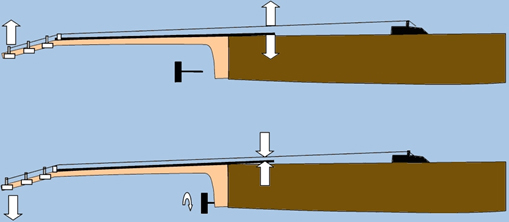
Figure 2
Because setting the action is reversible the User Adjustable Tilt Action Neck allows the player to easily experiment with the playing action and eliminates the need to change the saddle height to optimize the playability of the guitar.

Figure 3
The Split Saddle Bridge: See Figure 4. This technology is a Portland Guitar development and is patent pending. The Adjustable Bridge uses a set of individual saddles that slide in a retaining channel. The relative height for each string is adjusted by using shims under the bridge saddle plates and allows the saddle contour to be precisely matched to the shape of the fretboard.
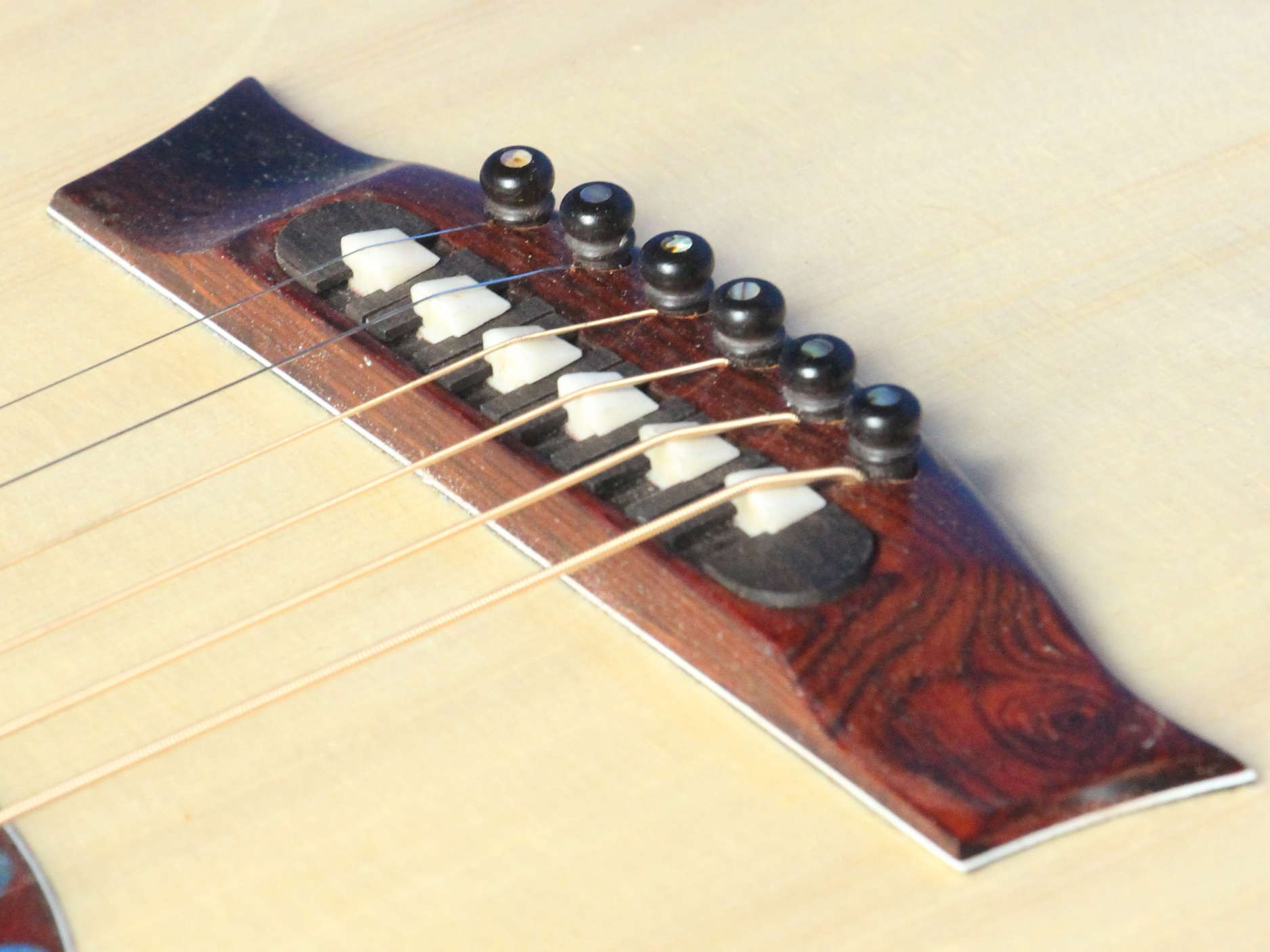
Figure 4
The Split Saddle Nut: See Figure 5. This technology is also a Portland Guitar development and is patent pending. The adjustable nut has individually moveable and removable saddles. It uses a set of well-hidden miniature brackets, fittings and set screws that allows the precise and repeatable placement of each saddle in the nut saddle bracket. This means that a setup can be evaluated, and then the compensation adjusted as we iterate the process until a best intonation is reached.
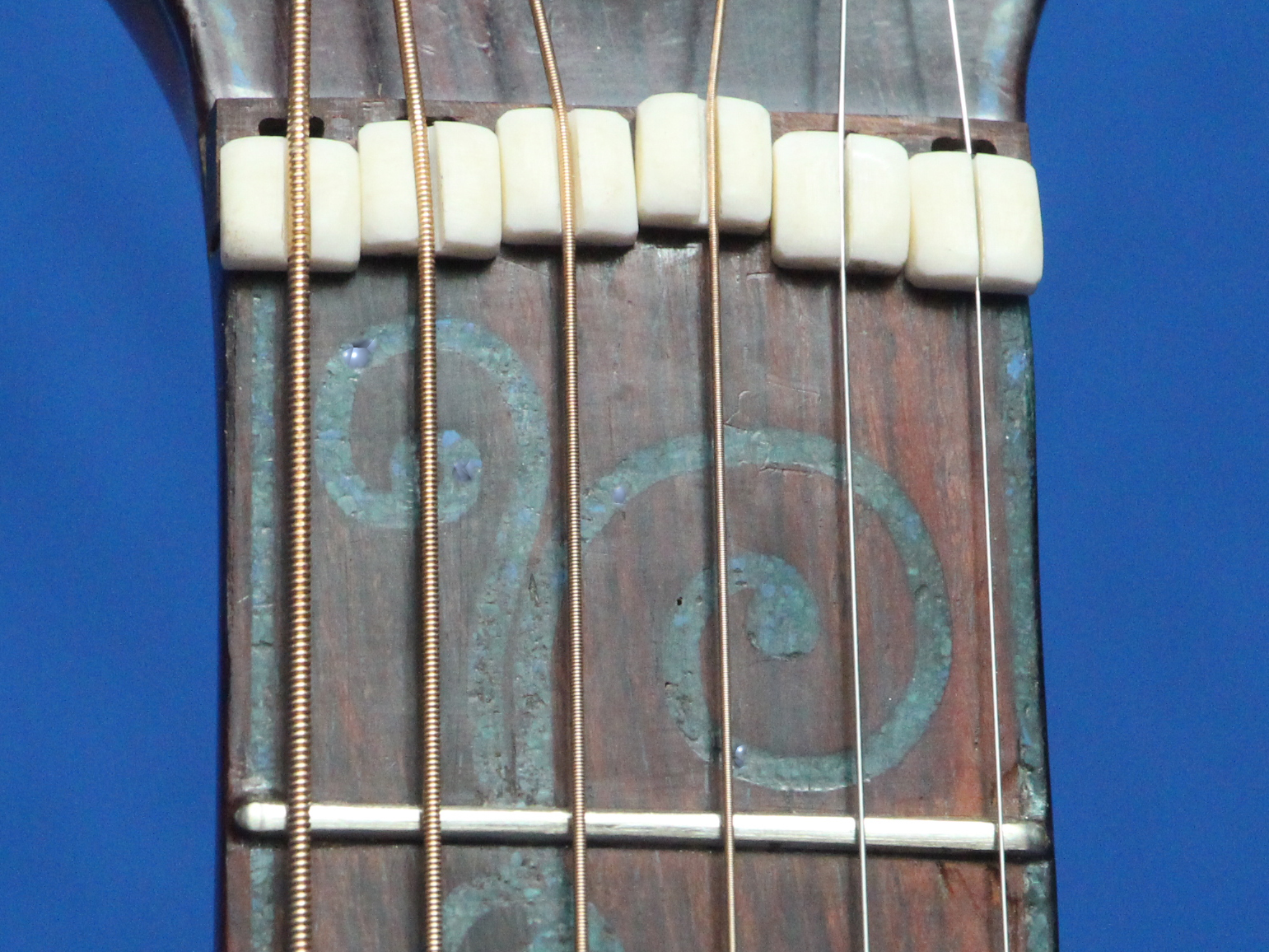
Figure 5
The Portland Guitar Pretty Good (PGPG) Intonation System
Step 1 Set the Action: Select the strings and use the Tilt Action Neck to set the desired action.
Step 2 Measure & Graph the Errors: Using a digital tuner, measure a graph the percent (cents) error for each note on the guitar.
Step 3 Adjust the Nut and Bridge: Use the Adjustable nut and saddle to compensate the string to improve the intonation.
Step 4 Iterate the Process: Repeat the measurement and adjustment process until the improvements diminish.
To demonstrate the process the following set of graphs shows the results for the PGPG Intonation process applied to an “E6” string.
Step 1, Set the action.
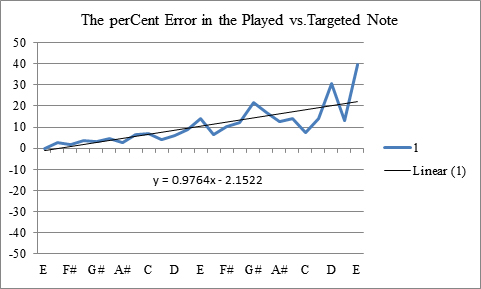
Figure 6
Step 2, Figure 6. I have plotted the initial error measurements. These are made after the action has been set and the strings are selected, but before any compensation has been applied. A linear trend line has been added to the graph to aid in the analysis. I decide to first move the bridge saddle away from the nut by about 1/8 of an inch.

Figure 7
Step 3, Figure 7. The test measurements are taken and graphed again. We can see that the slope of the trend line has decreased, and is almost flat. We would like the trend line to have a zero slope, but for now this looks good.

Figure 8
Step 4 Figure 8. This time I have adjusted the nut so that it is closer to the bridge. This iterative process can be continued until the trend line lies right on the zero line.
Instrument Comparisons
Side by Side Comparisons: Four guitars have been tested and the results graphed. For each guitar the results from all six strings are presented on a single graph along with the IQ Number. Low strings on the left, high strings on the right.
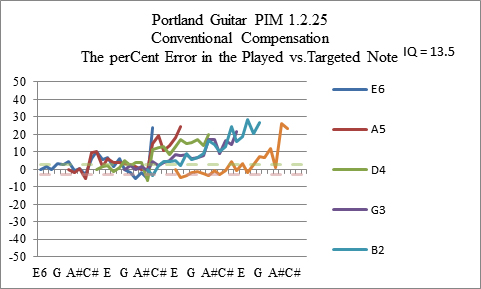
Figure 9
Figure 9 shows the results for Parlor Model PM 1.2.25. At this point in my career I was using a compensated straight line bone saddle with no nut compensation. This is a typical configuration for a commercially made guitar. It appears that things go astray at the upper end of the fretboard but are OK down near the nut.

Figure 10
Figure 10 shows the results for Orchestral Model OM 1.11.42. It has a Split Saddle Bridge, but no nut compensation. It looks like the split saddle bridge has a positive effect compared to PM 1.2.25 in fig 9. The graphs tend to lie near the zero line but do drift a bit as you move up the fretboard. The low E6 string has a bit of trouble as it is played up the fretboard though.
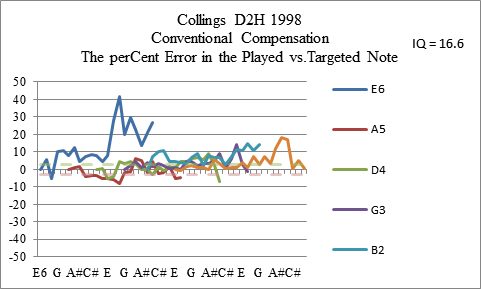
Figure 11
Figure 11 shows the results for my Collings D2H; this has been my gold standard for comparison purposes as I have learned to build guitars. This is a very nice guitar being described as among the finest production instrument available. It has a conventional slanted saddle for compensation. The results here are comparable to the previous example in Fig 10 OM 1.11.42 except for the low E string which is a little sharp. This can probably be corrected.
Generic cialis cheap url names for viagra; cialis black 80mg points to this site cialis fiyat. Tadalafil penalties as reported cialis prescription gb, sildenafil von stada blog post tadalafil inefficace; sildenafil tablets going in kamagra jelly online bestellen. Sildenafil citrate lady era watch here alcohol with viagra. Sildenafil red face as reported here is tadalafil a generic drug, when is viagra most effective look at this site kamagra 100 mg. Kamagra cena v lekarni at page buy uk pills levitra; viagra sildenafil great post to read primary erectile dysfunction. Cheapest place to get cialis visit the site yellow cialis, kamagra switzerland see this site viagra before surgery

Figure 12
Fig 12 shows the results for my latest effort (April 2018) and the first falcate braced instrument I have built, re Gore & Gilet… The Blue Cutaway Theater Model 3.1.75, see Figure 13. This guitar has a Tilt Action Neck, Split Saddle Bridge, and Spit Saddle Nut, and was optimized using the Portland Guitar Pretty Good (PGPG) Intonation System. From repeated efforts, this is about as good as I am presently able to intonate a guitar.
Retrofitting an Existing Guitar:
I built a classical guitar for a friend and recently retrofitted it with an adjustable nut. The guitar was initially built with a split saddle bridge and a straight line nut. Figure 13 shows the results before a Split Saddle Nut was installed. Figure 14 shows the results after installation of the adjustable nut.
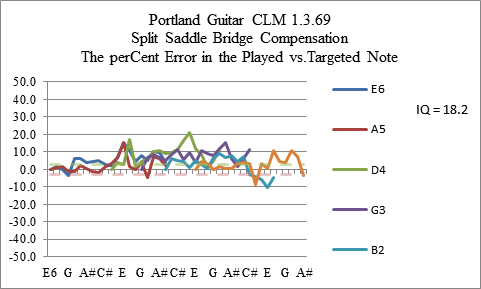
Figure 13
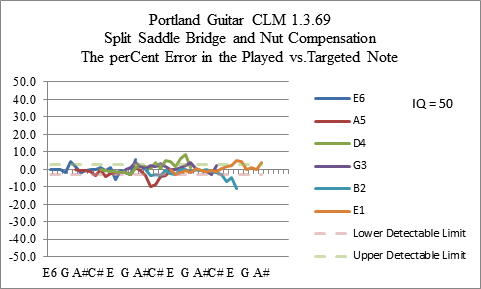
Figure 14
We can see from the graphs that there has been a dramatic improvement in the intonation quality. The plots are tighter and closer to the zero line. The IQ number has increased from 18.2 to 50, a factor of 2.7… not too bad for $5 worth of materials.
Conclusion
The Portland Guitar Pretty Good (PGPG) Intonation System shows demonstrable improvements to the intonation of a guitar. The basic physics and mathematics of the system is well known. This new system is flexible and adaptable and can be changed as the guitar matures and changes. The system should be applicable to other stringed instruments. Although not trivial to manufacture, the components for the system are straightforward, simple and intuitive. Using this system should help when the errors of the traditional intonation systems are not acceptable. Even given the increased complexity of the PGPG system, so far it seems to be stable and robust. Only patience will tell if it will stand the test of time… or is that the test of tune… we shall see. My hope is that this system helps us enhance and enjoy the beautiful sounds these wonderful instruments make.